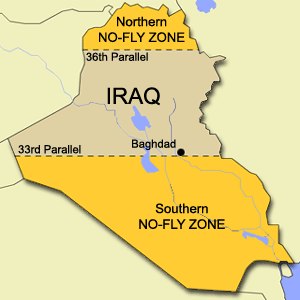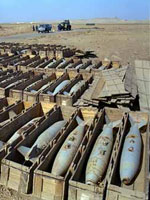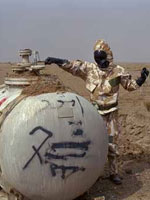Iraq in the Wake of the
Gulf War
 The
NO-FLY ZONES dictated by NATO U.N. Weapons Inspectors
Following the war, U.N. weapons inspectors (UNSCOM) were sent to Iraq
to identify non-conventional weapons of mass destruction, manufacturing
infrastructure, and delivery systems such as missiles.
It was quickly discovered that Iraq invested years of effort to develop
non-conventional weapons. It was also learned that many Western nations
provided technology in support of these efforts and the development of
ballistic missiles. Iraq admitted to its involvement in the production of
non-conventional weapons but argued that it had destroyed them all.
The Iraqi authorities opposed the inspectors’ work and tried to portray
them as a continuing effort to leave the sanctions in place. The U.N., and
the U.S. in particular, viewed Iraq’s arguments as proof that additional
weapons had still been left undiscovered by U.N. inspectors.
On November 13, 1997, Iraq expelled the American UNSCOM observers.
Tensions escalated over the following months and the U.S. began to
reinforce its forces in the Persian Gulf. In February 1998, U.N. Secretary
General Kofi Annan reached an agreement to calm tensions in the region,
but in the coming months, Iraq continued to interrupt UNSCOM’s efforts and
demanded that the sanctions against Iraq be removed. At the end of August
1998, Saddam Hussein ended the observers’ work.
On August 31, 1998, the U.S. and Britain threatened Iraq with military
action if Iraq would not cooperate. On November 14, Iraq agreed to
unconditional cooperation with U.N. inspectors, and the U.S. and Britain
withdrew their threat. On December 15, the U.N. Chief Inspector Richard
Butler announced that Iraq was not honoring its commitment to full
cooperation.
The next day, the U.S. and Britain initiated four days of air attacks
on Iraq. The attacks focused on command and control centers, missile
factories, and airfields. The U.S. and Britain continue a war of attrition
against Iraq, including air attacks on Iraqi targets in no-fly zones
determined after the 1991 war.
In 2000, the UNSCOM team was replaced by UNMOVIC after the Clinton
administration admitted that it had received intelligence reports from
UNSCOM weapons inspectors.
Flashpoints
In June 1993, during George Bush’s visit to Kuwait, an attempt was made
to assassinate the former President. President Clinton responded by
attacking Iraq with guided missiles. This attack represented the first
wave of renewed tension in the Gulf.
In 1994, Iraqi Republican Guard units proceeded toward the Kuwaiti
border and U.S. forces were again sent to the Gulf. Once Saddam perceived
the seriousness of the U.S. response, he withdrew his forces.
From this point onward, tensions in the region focussed on the work of
the U.N. inspectors. The scenario remained the same, i.e., Saddam Hussein
would not allow the inspectors to operate; the U.S. forces would flex
their muscle; and Saddam would withdraw his opposition.
In February 2001, U.S. forces attacked Iraqi air defenses. This action
was taken in response to a dramatic rise in the number of Iraqi attempts
to down U.S. aircraft patrolling over Iraq and to establish new command
centers.
In August 1996, the Iraqi army invaded the Kurdi province in
cooperation with the KDP (Kurdish Democratic Party). The Iraqis conquered
the city of Arbil from the PVK (Kurdish Opposition Party). After a number
of weeks, the Iraqis withdrew from the city and returned it to the control
of Barzani, leader of the KDP. |

 Bombs discovered by U.N. inspectors
Bombs discovered by U.N. inspectors  U.N. inspector checking a container for chemical agents
U.N. inspector checking a container for chemical agents
